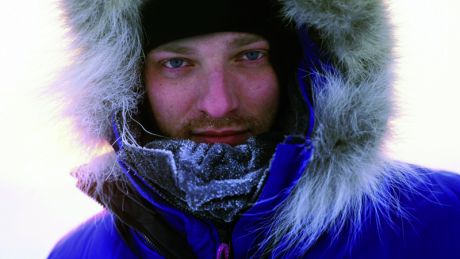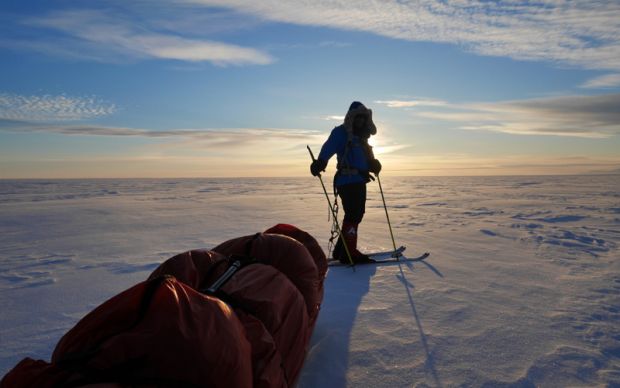How To Walk The Antarctic (Without Freezing To Death) With Ben Saunders
Polar explorer Ben Saunders talks to us from the Antarctic as he attempts to recreate and complete Scott’s ill-fated expedition

Where are you now?
We’re in our tent on the Antarctic Plateau. We reached our halfway mark – the South Pole – yesterday and are now retracing our steps towards the coast.
What made you decide to recreate the Terra Nova expedition?
I’ve always been fascinated by Scott’s story. He was a childhood hero of mine. In many ways the Terra Nova expedition is a tragic story but its successes are often overlooked. I find it fascinating that in all the years since (more than 100 of them) and given everything we’ve learned – from solar panels to scurvy – no-one has man-hauled further in Antarctica than the 1,600 miles or so that Scott, Wilson and Bowers had covered when they died, and that no-one has completed their journey since. This outstanding physical feat remains the high watermark of human endeavour in the toughest environment on the planet. As an athlete I hope to raise the bar in my chosen field but also to share and honour Scott and his team’s incredible achievement . I want to celebrate his legacy in a way that will inspire generations worldwide for years to come.
What physical training did you do to prepare for this trip?
I've spent the best part of the past 12 months preparing physically for the Scott Expedition, with 15 to 20 hours of endurance and strength work per week – primarily gym-based strength training and cardio on my bike or running. When I’m not on the ice my home is in London, but few things makes me happier than throwing my walking boots, my running shoes and my dog in the back of my Land Rover and escaping to the West Country, Wales, Scotland or the Alps.
Did any of the challenges you came up against in previous expeditions make you change your preparations all?
Every expedition has prepared me in some way for the next. Nutrition is one thing I’ve really focused on developing for the Scott Expedition. We slightly misjudged our nutrition on my first expedition in 2001, which meant food became both a recurring theme for daydreams and an awkward thing to share fairly between us. We’ve had food cravings in Antarctica but I’m pleased to say that at no point has our 6,000 calorie-per-day menu left us feeling hungry.
Is there a single piece of consumer tech other than clothing that you’re completely dependent on while you’re there?
We’re carrying a Sony Vaio Pro Ultrabook with Intel’s latest fourth-generation technology to blog daily from our tent. It makes such a difference to have a full keyboard rather than the handheld device I’ve used for basic text on previous expeditions, and it enables us to send back video and images. We use it every day.
What other pieces of kit are essential and why?
Our Hilleberg Keron tent is important for shelter, and our layered clothing includes a custom-made Mountain Equipment windproof outer shell to keep us safe and warm from the elements. We also have a NAL Shout Nano tracker – an always-on tracking beacon that sends our GPS co-ordinates back to the UK-based support team hourly.

What has been the most challenging part of the trip so far, physically and mentally?
The worst moments were probably during the earliest days of the expedition when our sleds weighed almost 200kg each and it took all the energy we could muster to inch them forward every day. Given that we had over 1,700 miles to go at the time, it was physically draining and fairly demoralising to see that we’d travelled only seven or eight miles despite our toil. Another challenge was acclimatising to the altitude as we reached the top of the Beardmore Glacier and began crossing the Antarctic Plateau. We were physically exhausted and the conditions were rarely in our favour. At times like this you have to look to the short term and focus on the next step, the next session and the next distance goal.
Sign up for workout ideas, training advice, reviews of the latest gear and more.
While you’re plodding along, do you think about other things or do you have to be laser focused on what’s in front of you?
When you’re leading it’s obviously important that you focus on navigation, but of course there are times when my mind wanders. It often makes skiing far more enjoyable if I dream of places at home or take myself on walks through London or some of my favourite routes in the Brecon Beacons. I also spend a fair amount of time each day considering what I’m going to write in the evening blog. Thinking of other things takes the focus off aches and pains and makes the miles pass much more quickly.
How do you feel a trip like this changes you?
I think that’s one for when I’m back. It’s hard to tell when you’re still out here. Antarctica certainly gives you perspective to consider what’s important in your every day life back at home.
Given the opportunity, would you be interested in space exploration?
When I was younger I wanted to be an astronaut and in many ways the methodical planning and preparation for this trip felt a little like what it might be like to prepare to go to space. The polar regions are where my heart lies at the moment but I wouldn’t rule it out at some point if an opportunity arose.
What are your guilty listening pleasures while trekking?
I listen to music a lot when I'm skiing – usually electronic music. The tougher the conditions the faster the music generally gets, so if it’s a really tough day I often listen to drum’n’bass.
For more information and to follow Ben's progress, check out the Scott Expedition blog.
Nick Hutchings worked for Men’s Fitness UK, which predated, and then shared a website with, Coach. Nick worked as digital editor from 2008 to 2011, head of content until 2014, and finally editor-in-chief until 2015.
